- genevb's home page
- Posts
- 2025
- 2024
- 2023
- 2022
- September (1)
- 2021
- 2020
- 2019
- December (1)
- October (4)
- September (2)
- August (6)
- July (1)
- June (2)
- May (4)
- April (2)
- March (3)
- February (3)
- 2018
- 2017
- December (1)
- October (3)
- September (1)
- August (1)
- July (2)
- June (2)
- April (2)
- March (2)
- February (1)
- 2016
- November (2)
- September (1)
- August (2)
- July (1)
- June (2)
- May (2)
- April (1)
- March (5)
- February (2)
- January (1)
- 2015
- December (1)
- October (1)
- September (2)
- June (1)
- May (2)
- April (2)
- March (3)
- February (1)
- January (3)
- 2014
- December (2)
- October (2)
- September (2)
- August (3)
- July (2)
- June (2)
- May (2)
- April (9)
- March (2)
- February (2)
- January (1)
- 2013
- December (5)
- October (3)
- September (3)
- August (1)
- July (1)
- May (4)
- April (4)
- March (7)
- February (1)
- January (2)
- 2012
- December (2)
- November (6)
- October (2)
- September (3)
- August (7)
- July (2)
- June (1)
- May (3)
- April (1)
- March (2)
- February (1)
- 2011
- November (1)
- October (1)
- September (4)
- August (2)
- July (4)
- June (3)
- May (4)
- April (9)
- March (5)
- February (6)
- January (3)
- 2010
- December (3)
- November (6)
- October (3)
- September (1)
- August (5)
- July (1)
- June (4)
- May (1)
- April (2)
- March (2)
- February (4)
- January (2)
- 2009
- November (1)
- October (2)
- September (6)
- August (4)
- July (4)
- June (3)
- May (5)
- April (5)
- March (3)
- February (1)
- 2008
- 2005
- October (1)
- My blog
- Post new blog entry
- All blogs
Looking into event-by-event T0 in FXT
Updated on Fri, 2023-07-21 01:42. Originally created by genevb on 2023-07-19 14:23.
My initial findings on this urgent topic using prompt hits in 5000 events from Run 19 3.85 GeV FXT....
I looked at two choices for the time of the event as seen by the prompt hits. The below two plots show the time distribution before any corrections other than a rough guess at an offset for the mean to put it near zero. What is important is the widths of the distributions, which are roughly 15 ns in both cases. This is the width we want to reduce by correction for the true event time with respect to the RHIC clock. Both distributions show a notable tail to one side (early events?).
left: using an average of all of the TPC prompt hits
right: using only the east side
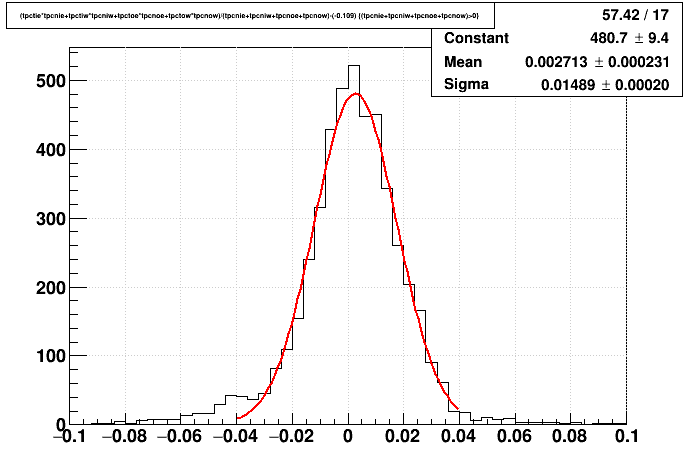
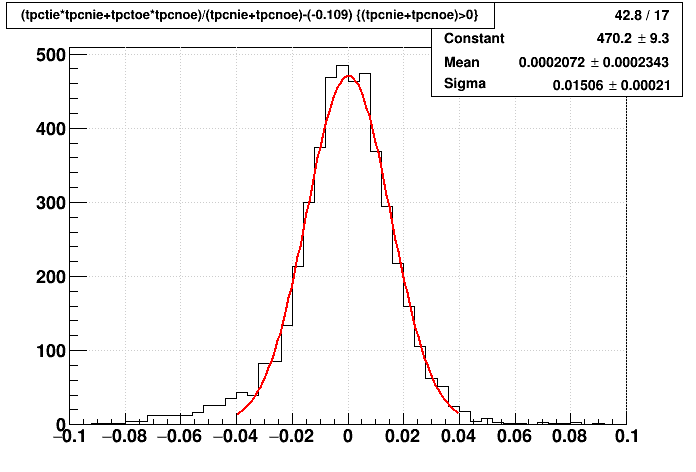
The next set of plots show the dependencies of the time determined from all prompt hits versus...
top left: Irakli's max EPD TAC (~90% EPD west)
top middle: Irakli's max EPD TAC only accepting east-side hits
top right: Gene's earliest EPD west
lower left: Gene's earliest EPD east
lower middle: Gene's earliest BBC east
lower right: Gene's earliest VPD east
The number of entries in the plots is determined by the efficiency of having a non-zero value for the used quantities. The error bars here represent the spread, not the error-on-the-mean. The red lines are a simple linear fit over a range I chose by eye to avoid the edges of the distributions.
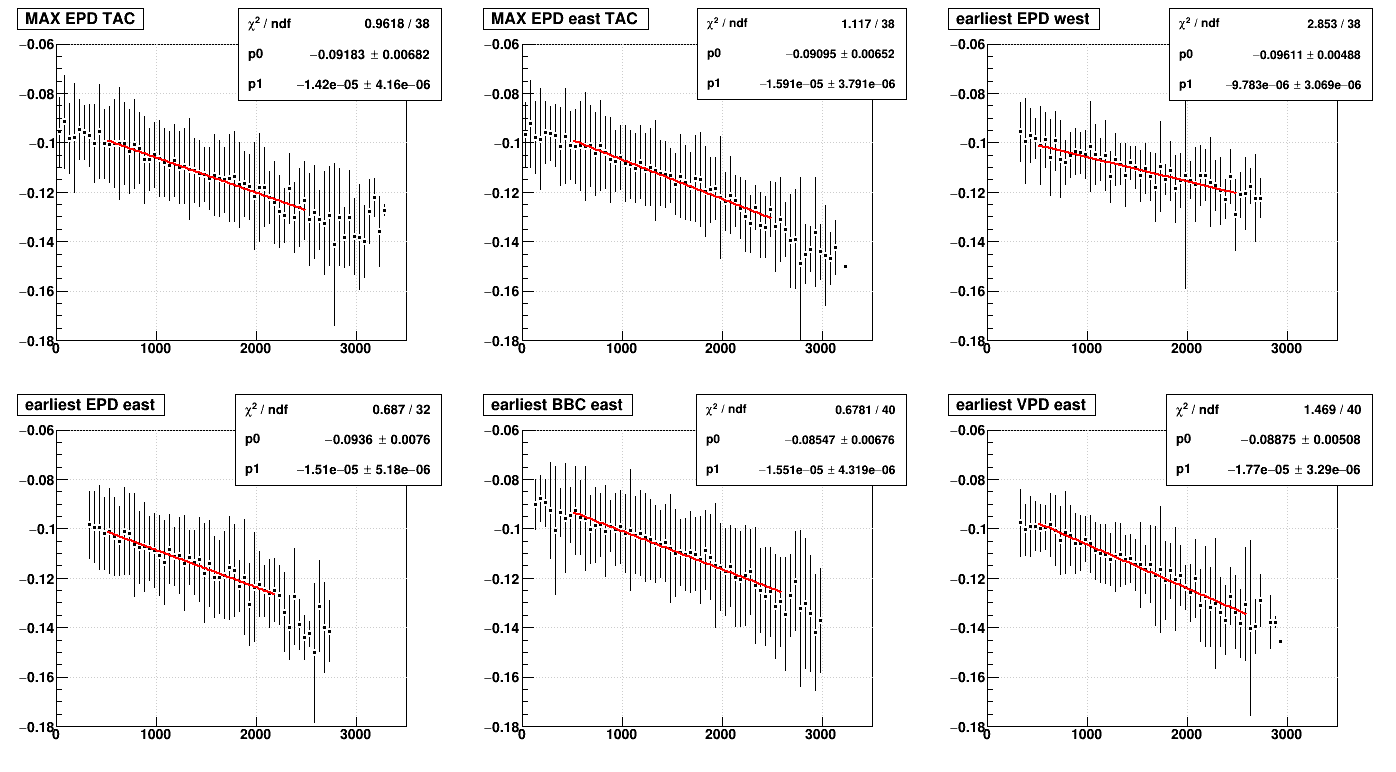
Using the above linear fits, I corrected the TPC prompt hit times and measured the distribution widths:
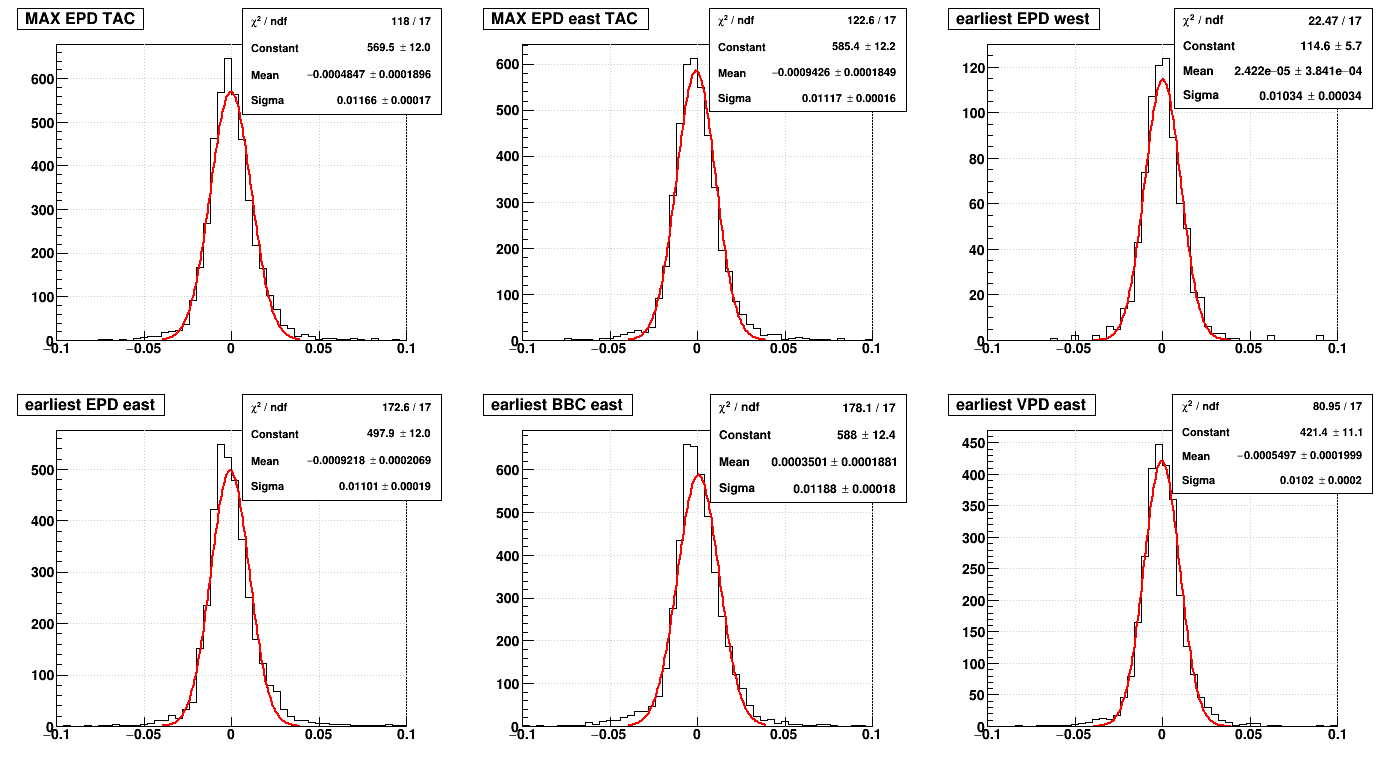
We can see that the width is reduced to around 10-12 ns. The VPD east seems to do the best, but only for 50-60% of events. EPD east (either Gene's or Irakli's) seems to be next best. The BBC isn't any better than Irakli's MAX TAC, but is the efficiency leader as a backup choice when other detectors are not present.
The next sets of plots are identical to the above, but using only the east side TPC prompt hits to measure the TPC time. The conclusions are similar, and there is little else to say about it.
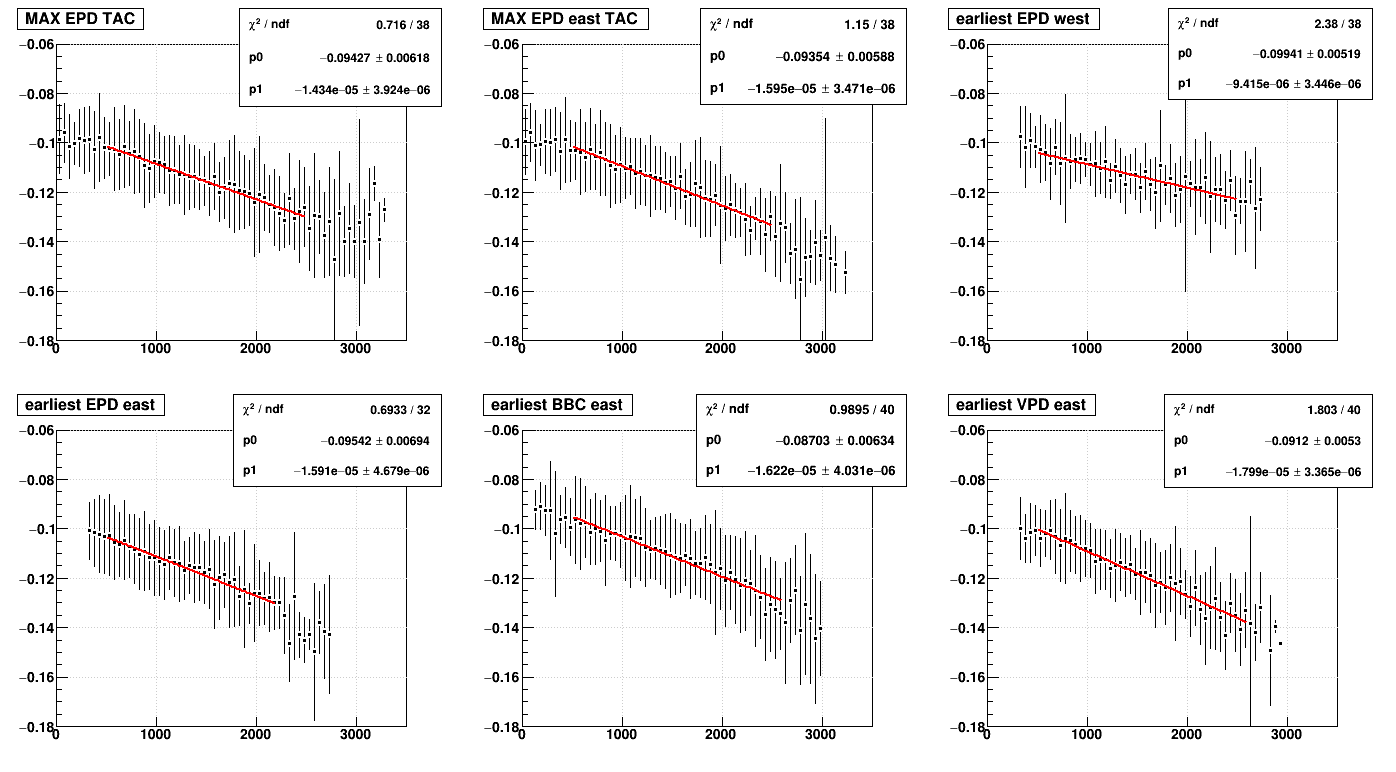
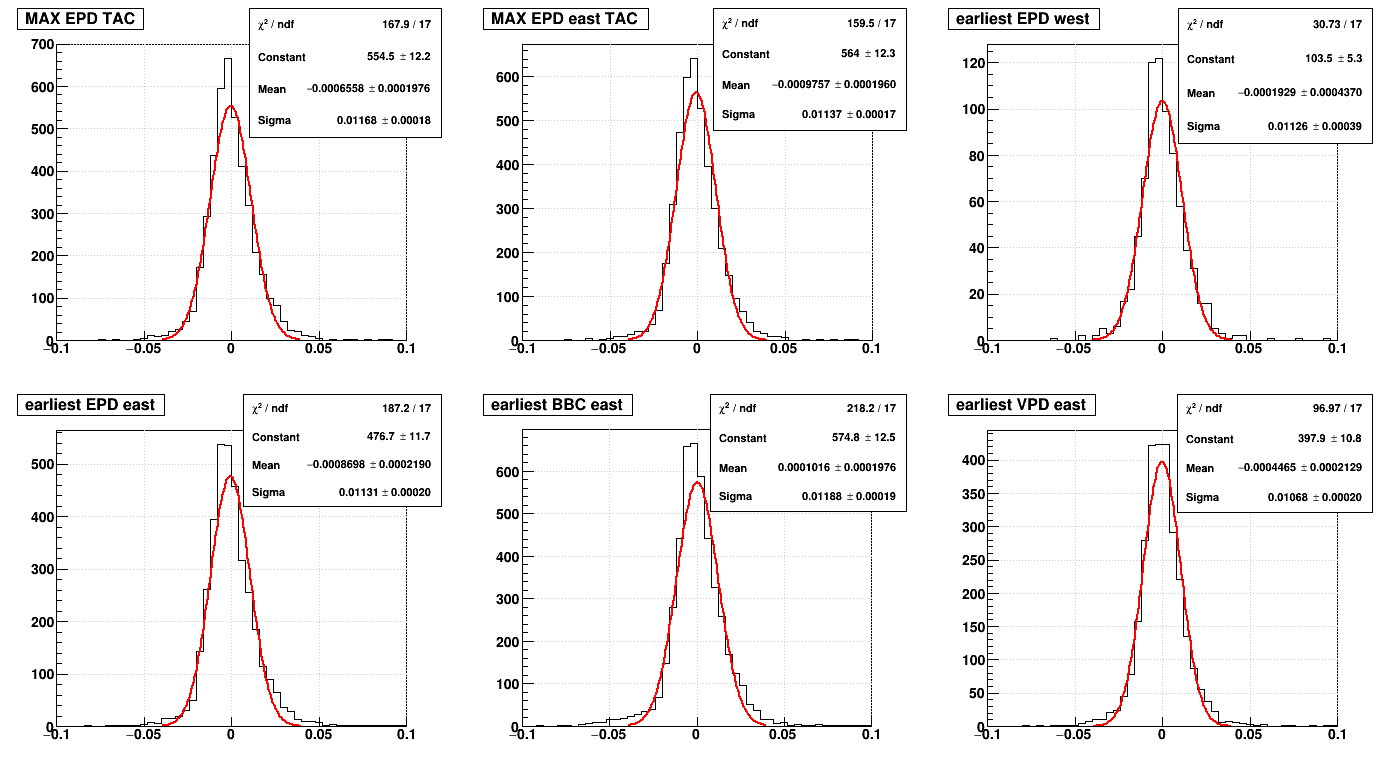
__________________________________________________
It's also worth looking at how Irakli's max EPD TAC correlates with some of Gene's quantities. From left to right are...
left: Gene's EPD west vs. Irakli's max EPD TAC (only for when it was from the west EPD)
middle left: Gene's EPD east vs. Irakli's max EPD TAC (restricted to using the east EPD)
middle right: Gene's BBC east vs. Irakli's max EPD TAC (restricted to using the east EPD)
right: Gene's VPD east vs. Irakli's max EPD TAC (restricted to using the east EPD)
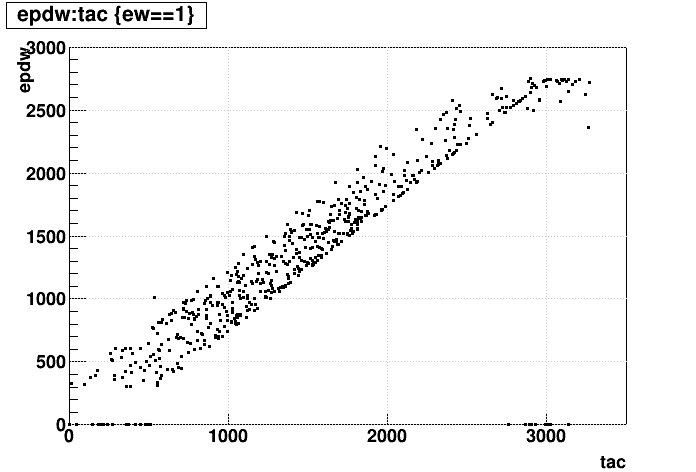

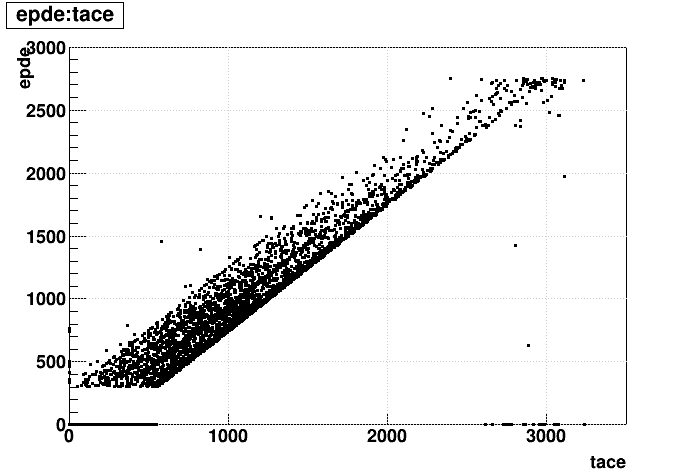
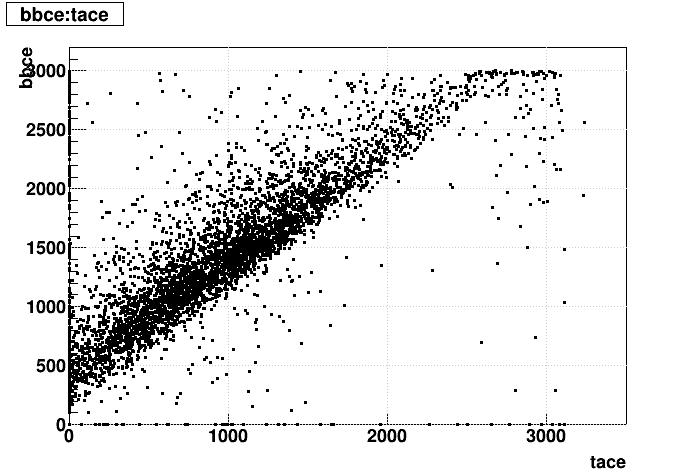
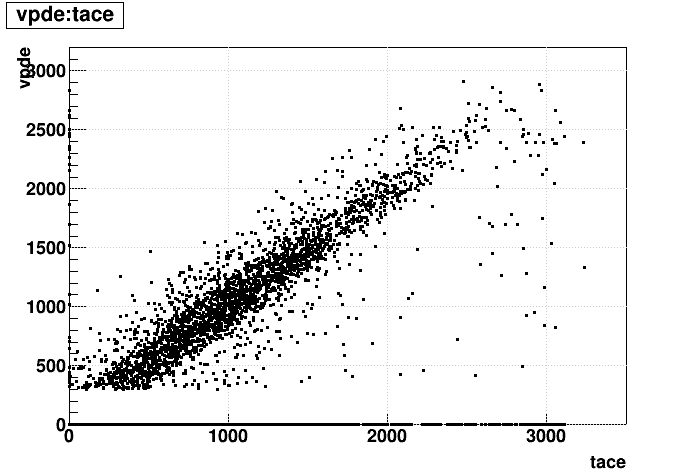
First, the BBC and VPD plots shows less correlation, which is to be expected given that they are separate detectors. The VPD does seem to show a rather strong central band though; better correlation than BBC.
We can see some clear bands in the EPD east plot, which are also present in the EPD west plot. It's unclear what caused these. Here is the difference of the two EPD east measurements (from Gene and Irakli) vs. event in the file, and vs. the 9 tiles from which hits can come. There is no dependence apparent for either of these.

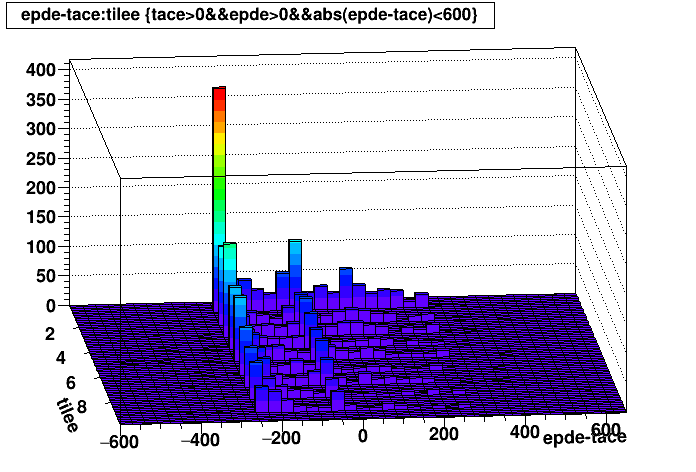
My best guess for whether the banding is a feature of Irakli's MAX EPD east TAC or Gene's earliest EPD east time comes from looking at the spread in the difference between either of these with a third quantity, either earliest BBC east time or earliest VPD east time (shown below, where black is Gene's and red is Irakli's). It turns out that these spreads are quite significantly narrower for Gene's earliest EPD east time that Irakli's MAX EPD east TAC, implicating the latter to be the more problematic. There is a the possibility (less likely perhaps?) that the banding is from a common source to all the earliest time measurements (RHIC clock jitter?).
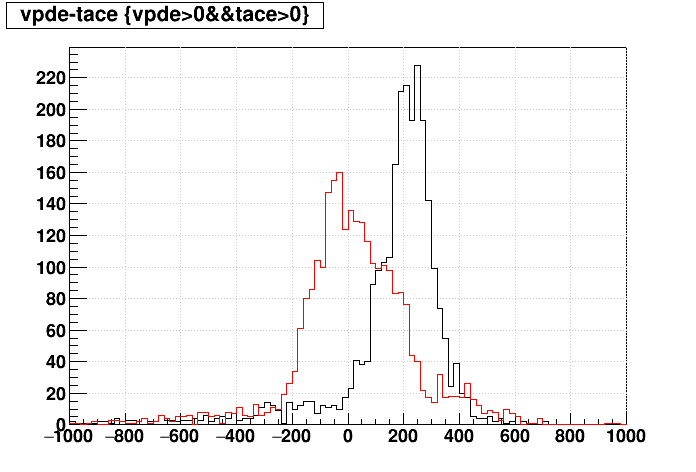
-Gene
- Irakli's calibration of dependence on EPD max TAC (earlier time hit) may be roughly determined in terms of the coefficient (slope) of the correlation with TPC T0. I believe Irakli has 16.0 ps / TAC channel in his calibration for this dataset, while Rosi says that number should be 15.6 ps / TAC channel (ref).
- Further below, I will show my investigation of how tightly the EPD is correlated to the TPC timing.
- One other factor I haven't yet investigated: any overall offsets (static T0).
- Irakli's code loops over the collection of EPD hits to find the one with the maximum TAC (larger TAC = earlier time), but my code uses the StTriggerData class with its functions: xxxEarliestTDC(StBeamDirection), where the direction is either east or west, and xxx is in (vpd,epd,bbc,zdc). These appear to give somewhat different results, and I show this down at the bottom of this page.
- Irakli's code doesn't care whether the EPD hit is from the east or west EPD. In this FXT data, the max TAC he finds is from the west side 12% of he time. This might make some sense in that the west is closer to the collision, but the fact that the west EPD is actually physically backwards of the target makes it hard to believe that the particles it sees are of interest to us for the collision timing.
- Irakli finds an EPD timing that he calls valid in over 99% of events (true of east and west, or east alone if we restrict), but roughly 10% of those events have a TAC that is "0" despite being "valid", which isn't really valid for a T0 correction calculation. Maybe the timer hit its maximum time? The StEpdHit::hasTac() and StEpdHit::isGood() functions don't seem to make a difference with these. This must contribute to a smearing, but only for order(~10%) of events.
- My code sees a much higher efficiency of valid times from EPD east (~80%) than EPD west (~15%).
- I see a valid BBC east time in essentially all events (nearly 100% efficiency), though BBC west is only ~10% efficient. At the very least, the BBC east is probably a good backup for when there is no valid EPD (east) time.
- The VPD east is much less efficient, somewhere between 50-60%.
I looked at two choices for the time of the event as seen by the prompt hits. The below two plots show the time distribution before any corrections other than a rough guess at an offset for the mean to put it near zero. What is important is the widths of the distributions, which are roughly 15 ns in both cases. This is the width we want to reduce by correction for the true event time with respect to the RHIC clock. Both distributions show a notable tail to one side (early events?).
left: using an average of all of the TPC prompt hits
right: using only the east side


The next set of plots show the dependencies of the time determined from all prompt hits versus...
top left: Irakli's max EPD TAC (~90% EPD west)
top middle: Irakli's max EPD TAC only accepting east-side hits
top right: Gene's earliest EPD west
lower left: Gene's earliest EPD east
lower middle: Gene's earliest BBC east
lower right: Gene's earliest VPD east
The number of entries in the plots is determined by the efficiency of having a non-zero value for the used quantities. The error bars here represent the spread, not the error-on-the-mean. The red lines are a simple linear fit over a range I chose by eye to avoid the edges of the distributions.

Using the above linear fits, I corrected the TPC prompt hit times and measured the distribution widths:

We can see that the width is reduced to around 10-12 ns. The VPD east seems to do the best, but only for 50-60% of events. EPD east (either Gene's or Irakli's) seems to be next best. The BBC isn't any better than Irakli's MAX TAC, but is the efficiency leader as a backup choice when other detectors are not present.
The next sets of plots are identical to the above, but using only the east side TPC prompt hits to measure the TPC time. The conclusions are similar, and there is little else to say about it.


__________________________________________________
It's also worth looking at how Irakli's max EPD TAC correlates with some of Gene's quantities. From left to right are...
left: Gene's EPD west vs. Irakli's max EPD TAC (only for when it was from the west EPD)
middle left: Gene's EPD east vs. Irakli's max EPD TAC (restricted to using the east EPD)
middle right: Gene's BBC east vs. Irakli's max EPD TAC (restricted to using the east EPD)
right: Gene's VPD east vs. Irakli's max EPD TAC (restricted to using the east EPD)




First, the BBC and VPD plots shows less correlation, which is to be expected given that they are separate detectors. The VPD does seem to show a rather strong central band though; better correlation than BBC.
We can see some clear bands in the EPD east plot, which are also present in the EPD west plot. It's unclear what caused these. Here is the difference of the two EPD east measurements (from Gene and Irakli) vs. event in the file, and vs. the 9 tiles from which hits can come. There is no dependence apparent for either of these.


My best guess for whether the banding is a feature of Irakli's MAX EPD east TAC or Gene's earliest EPD east time comes from looking at the spread in the difference between either of these with a third quantity, either earliest BBC east time or earliest VPD east time (shown below, where black is Gene's and red is Irakli's). It turns out that these spreads are quite significantly narrower for Gene's earliest EPD east time that Irakli's MAX EPD east TAC, implicating the latter to be the more problematic. There is a the possibility (less likely perhaps?) that the banding is from a common source to all the earliest time measurements (RHIC clock jitter?).

-Gene
»
- genevb's blog
- Login or register to post comments
